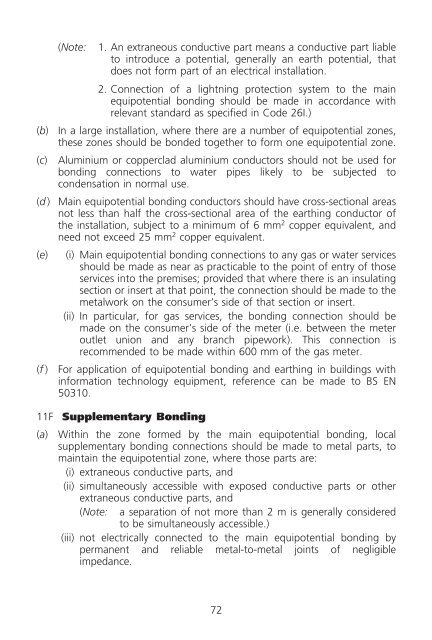Code of Practice for the Electricity (Wiring) Regulations - 2009 Edition
Code of Practice for the Electricity (Wiring) Regulations - 2009 Edition
Code of Practice for the Electricity (Wiring) Regulations - 2009 Edition
You also want an ePaper? Increase the reach of your titles
YUMPU automatically turns print PDFs into web optimized ePapers that Google loves.
(Note: 1. An extraneous conductive part means a conductive part liable<br />
to introduce a potential, generally an earth potential, that<br />
does not <strong>for</strong>m part <strong>of</strong> an electrical installation.<br />
(Note: 2. Connection <strong>of</strong> a lightning protection system to <strong>the</strong> main<br />
equipotential bonding should be made in accordance with<br />
relevant standard as specified in <strong>Code</strong> 26I.)<br />
(b) In a large installation, where <strong>the</strong>re are a number <strong>of</strong> equipotential zones,<br />
<strong>the</strong>se zones should be bonded toge<strong>the</strong>r to <strong>for</strong>m one equipotential zone.<br />
(c) Aluminium or copperclad aluminium conductors should not be used <strong>for</strong><br />
bonding connections to water pipes likely to be subjected to<br />
condensation in normal use.<br />
(d ) Main equipotential bonding conductors should have cross-sectional areas<br />
not less than half <strong>the</strong> cross-sectional area <strong>of</strong> <strong>the</strong> earthing conductor <strong>of</strong><br />
<strong>the</strong> installation, subject to a minimum <strong>of</strong> 6 mm2 copper equivalent, and<br />
need not exceed 25 mm2 copper equivalent.<br />
(e) (i) Main equipotential bonding connections to any gas or water services<br />
should be made as near as practicable to <strong>the</strong> point <strong>of</strong> entry <strong>of</strong> those<br />
services into <strong>the</strong> premises; provided that where <strong>the</strong>re is an insulating<br />
section or insert at that point, <strong>the</strong> connection should be made to <strong>the</strong><br />
metalwork on <strong>the</strong> consumer’s side <strong>of</strong> that section or insert.<br />
(ii) In particular, <strong>for</strong> gas services, <strong>the</strong> bonding connection should be<br />
made on <strong>the</strong> consumer’s side <strong>of</strong> <strong>the</strong> meter (i.e. between <strong>the</strong> meter<br />
outlet union and any branch pipework). This connection is<br />
recommended to be made within 600 mm <strong>of</strong> <strong>the</strong> gas meter.<br />
(f ) For application <strong>of</strong> equipotential bonding and earthing in buildings with<br />
in<strong>for</strong>mation technology equipment, reference can be made to BS EN<br />
50310.<br />
11F Supplementary Bonding<br />
(a) Within <strong>the</strong> zone <strong>for</strong>med by <strong>the</strong> main equipotential bonding, local<br />
supplementary bonding connections should be made to metal parts, to<br />
maintain <strong>the</strong> equipotential zone, where those parts are:<br />
(i) extraneous conductive parts, and<br />
(ii) simultaneously accessible with exposed conductive parts or o<strong>the</strong>r<br />
extraneous conductive parts, and<br />
(Note: a separation <strong>of</strong> not more than 2 m is generally considered<br />
to be simultaneously accessible.)<br />
(iii) not electrically connected to <strong>the</strong> main equipotential bonding by<br />
permanent and reliable metal-to-metal joints <strong>of</strong> negligible<br />
impedance.<br />
72














